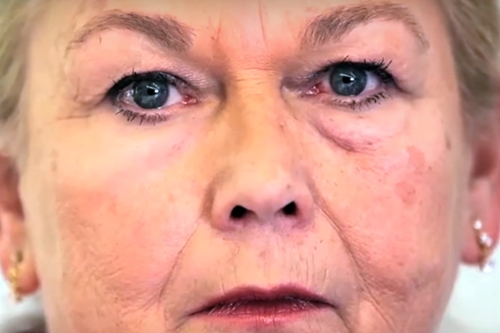
Skin under the eye on the left is treated with XPL, while skin under the other eye is untreated (Olivio Labs and Mass. Institute of Technology)
9 May 2016. A substance that emulates properties of youthful human skin was shown in pilot tests with human subjects to outperform other materials used for wound dressings. The new polymer material, based on research at Massachusetts Institute of Technology and commercialized by Olivo Laboratories, a start-up enterprise, is described in today’s issue of the journal Nature Materials (paid subscription required).
The skin-like material was designed in the labs of MIT biotechnology professor Robert Langer and chemical engineering professor Daniel Anderson to meet both cosmetic and clinical needs, particularly for older individuals with whom skin becomes less elastic and less able to withstand extreme temperatures and radiation. The material is a silicone-based cross-linked polymer, tuned to meet specifications for elasticity, adhesion, strength, and moisture retention. With further work, say its developers, the material can also be used to deliver drugs and protect against damaging ultraviolet rays.
Olivo Laboratories, a start-up company about 1 year old co-founded by Langer and Anderson, is taking the material to market. The company is a spin-off from Living Proof — another company founded by Langer, Anderson and others — developing compounds that make hair more flexible and feel fuller. Researchers from Olivio Labs and Living Proof are co-authors of the Nature Materials paper.
The Olivio Labs material is a derivative of siloxane, a polymer with alternating oxygen and silicon atoms. The research team tested more than 100 cross-linked siloxane candidates looking for one material that best emulates human skin. “It has to have the right optical properties,” says Langer in an MIT statement, “otherwise it won’t look good, and it has to have the right mechanical properties, otherwise it won’t have the right strength and it won’t perform correctly.”
The new material, called XPL for cross-linked polymer layer, is applied in two steps. In the first step, a layer of siloxane is spread on the skin, followed by a platinum catalyst that forms the cross-linked film. Both components are applied like ointments, invisible to the eye, and can last on the skin for up to 24 hours. No curing with heat or light is needed.
In stretch tests, XPL film on the skin was found to have elasticity that outperformed materials now used as wound dressings, polyurethane films and sheets of silicone gel. The Olivio material could be stretched up to 250 percent and still return to its original state. In comparison, human skin can be stretched up to 180 percent. Other tests of tensile strength found XPL comparable to human skin.
Perhaps the most marketable property of XPL is its ability to tighten skin, including lower eyelid fat pads, known as eye bags. In tests with 12 human subjects, XPL was found to measurably reshape eye bags and enhance skin hydration. None of the subjects reported any irritation from wearing XPL.
The researchers note that clinical applications of XPL are still being developed. Co-author Rox Anderson of Harvard Medical School, also a co-founder of Olivio Labs, says in a company statement, “For eczema or sun protection as examples, this second skin platform can then serve as a reservoir for control-release transdermal drug delivery or SPF ingredients, a possibility we are currently pursuing in our lab.”
Langer and Anderson tell more about XPL in the following video.
- Electric Current Shown to Reduce Wound Bacteria
- Sensor Quickly Detects Bacteria in Wounds
- Licensing, Research Deal Aims at Chronic Wound Treatments
- Faster Process Devised for Skin-Patch Sensors
- Manufacturing Process Devised for Skin-Patch Electronics
* * *

 RSS - Posts
RSS - Posts
[…] MIT Spin-Off Develops Material Mimicking Human Skin […]